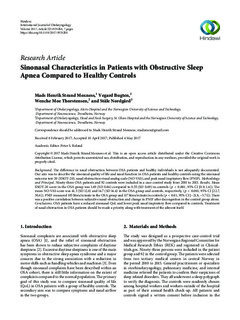| dc.contributor.author | Moxness, Mads Henrik Strand | |
| dc.contributor.author | Bugten, Vegard | |
| dc.contributor.author | Thorstensen, Wenche Moe | |
| dc.contributor.author | Nordgård, Ståle | |
| dc.date.accessioned | 2017-11-08T09:21:35Z | |
| dc.date.available | 2017-11-08T09:21:35Z | |
| dc.date.created | 2017-05-05T08:59:35Z | |
| dc.date.issued | 2017 | |
| dc.identifier.citation | International Journal of Otolaryngology. 2017, 2017 . | nb_NO |
| dc.identifier.issn | 1687-9201 | |
| dc.identifier.uri | http://hdl.handle.net/11250/2464832 | |
| dc.description.abstract | Background. The difference in nasal obstruction between OSA patients and healthy individuals is not adequately documented. Our aim was to describe the sinonasal quality of life and nasal function in OSA patients and healthy controls using the sinonasal outcome test-20 (SNOT-20), nasal obstruction visual analog scale (NO-VAS), and peak nasal inspiratory flow (PNIF).
Methodology and Principal. Ninety-three OSA patients and 92 controls were included in a case-control study from 2010 to 2015.
Results. Mean SNOT-20 score in the OSA group was 1.69 (SD 0.84) compared to 0.55 (SD 0.69) in controls (p <0.001, 95% CI [0.9, 1.4]). The mean NO-VAS score was 41.3 (SD 12.8) and 14.7 (SD 14.4) in the OSA group and controls, respectively, (p < 0.001, 95% CI [22.7, 30.6]). PNIF measured 105 litres/minute in the OSA group and 117 litres/minute in controls (p < 0.01, 95% CI [−21.8, −3.71]). There was a positive correlation between subjective nasal obstruction and change in PNIF after decongestion in the control group alone.
Conclusions. OSA patients have a reduced sinonasal QoL and lower peak nasal inspiratory flow compared to controls. Treatment of nasal obstruction in OSA patients should be made a priority along with treatment of the ailment itself. | nb_NO |
| dc.language.iso | eng | nb_NO |
| dc.publisher | Hindawi Publishing Corporation | nb_NO |
| dc.rights | Navngivelse 4.0 Internasjonal | * |
| dc.rights.uri | http://creativecommons.org/licenses/by/4.0/deed.no | * |
| dc.title | Sinonasal Characteristics in Patients with Obstructive Sleep Apnea Compared to Healthy Controls | nb_NO |
| dc.type | Journal article | nb_NO |
| dc.type | Peer reviewed | nb_NO |
| dc.description.version | publishedVersion | nb_NO |
| dc.source.pagenumber | 7 | nb_NO |
| dc.source.volume | 2017 | nb_NO |
| dc.source.journal | International Journal of Otolaryngology | nb_NO |
| dc.identifier.doi | 10.1155/2017/1935284 | |
| dc.identifier.cristin | 1468291 | |
| dc.relation.project | Norges forskningsråd: 231741 | nb_NO |
| dc.description.localcode | © 2017 Mads Henrik Strand Moxness et al. This is an open access article distributed under the Creative Commons Attribution License, which permits unrestricted use, distribution, and reproduction in any medium, provided the original work is properly cited. | nb_NO |
| cristin.unitcode | 194,65,30,0 | |
| cristin.unitname | Institutt for nevromedisin og bevegelsesvitenskap | |
| cristin.ispublished | true | |
| cristin.fulltext | original | |
| cristin.qualitycode | 1 | |

